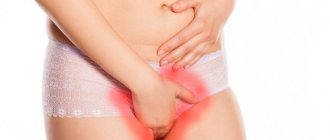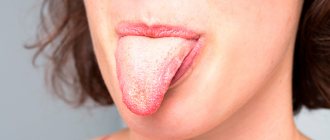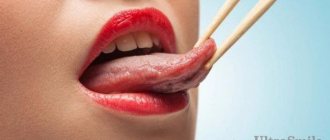It happens that some people who do not experience any health problems in general suddenly feel as if there is a hair in their mouth.
Desperate attempts to remove it do not lead to success, but only cause additional discomfort.
Of course, the reason may also be that hair actually gets into the mucous membrane.
But the feeling can also be illusory , which indicates pathologies in the body .
Causes of the sensation of hair in the mouth
Reference! A terrible feeling that haunts you day and night is usually an “alarm bell.” Thus, the body reports any violations that have arisen and calls for them to be eliminated immediately.
In medical practice, some diseases have been recorded, one of the symptoms of which is the sensation of a hair on the tongue or its root :
- First of all, it is a symptom of the initial stage of viral and bacterial infections;
- Chronic inflammatory diseases of the nasopharynx - laryngitis, tonsillitis and pharyngitis, which may be accompanied by a short-term sensation of hair in the throat;
- The feeling may signal iron deficiency anemia, endocrine pathology, or an increased level of protein in the blood ;
- Various allergic reactions to substances contained in the air, medications, or, for example, to new dentures or fillings;
- A long stay in a dusty, smoky, unventilated room can trigger the feeling of a hair;
- This symptom also occurs on a nervous basis , as a result of depressive and mental disorders;
- May indicate the onset of organic brain damage ;
- The sensation is quite rare, but occurs in people suffering from cervical osteochondrosis;
- An obsessive sensation of a hair is a sign of lead poisoning ;
- In addition, a real hair can actually get stuck on the tongue.
Keep in mind! As an independent disease, the symptom can be diagnosed as tactile hallucinosis.
This is a fairly rare mental syndrome that affects any analyzer. In this case, the feeling may appear and disappear suddenly, or torment the person for years.
Also, the sensation of hairs on the tongue can be a consequence of the development of a disgusting disease -
glossophytia , accompanied by the growth of filamentous receptors of the tongue.
Language structure
To understand what is happening and why the papillae of the tongue hypertrophy, let us consider its structure. It is a muscular organ that is covered with a mucous membrane. The body of the tongue is covered with papillae of four types:
- leaf-shaped, they are located on the lateral surface of the tongue and contain taste buds and glands that produce a secretion resembling viscous saliva;
- grooved, they are located at the root of the tongue, the largest and fewest papillae of the tongue, contain taste buds;
- mushroom-shaped, they are randomly located over the entire surface of the tongue, also containing taste buds;
- thread-like, the most numerous, located on the back of the tongue, their function is to retain food and touch, they do not contain taste buds.
Thus, the anatomy of the tongue lacks hair follicles from which hair grows. Therefore, the name “hairy tongue” is conditional. The overgrown filiform papillae are very reminiscent of hair.
Associated symptoms
If there really is a hair in the oral cavity, then the person feels:
- The presence of a foreign object that makes swallowing difficult;
- Constant desire to expel it by expectoration.
You should know! It’s another matter if we are talking about more than just a single sensation of a hair on the tongue.
When a symptom accompanies a number of signs , and there is actually no hair in the oral cavity, then this indicates the development of serious diseases .
Along with this unpleasant feeling, the following symptoms may occur :
- Irritation of the nasopharynx , accompanied by painful swallowing;
- Sore throat and urge to cough ;
- Unpleasant dryness , causing a desire to wet the throat;
- Difficulty breathing and hoarseness of voice ;
- Fever, swelling and lethargy;
- Feeling of nausea and vomiting ;
- Nervous obsessive states ;
- Changing the color of the tongue.
The presence of at least one of the listed signs is a reason to visit a doctor .
Remember! Timely detection of pathology will help protect health from possible serious consequences.
What to do if there is real hair there, how to get it?
First aid methods at home are simple. Especially if a person is in the country, outside the city, on the road or on vacation (there is no opportunity to immediately contact a specialist).
It is difficult to remove a hair or a stuck thread on your own; you will need an assistant .
- First, you need to carefully examine the oral cavity to find the “source” of irritation. To do this, it is better to use a table lamp or flashlight so that the cavity can be clearly seen even in the depths of the throat.
- Secondly, the easiest way is to simply swallow saliva several times so that a hair or foreign body enters the digestive tract.
- Thirdly, you can grab the hair with your fingers and pull it out .
Need to know! If this does not help, the hair is really stuck, you must perform the following procedures:
- Rinse your mouth or throat (depending on where the hair is located) with plenty of water . Use plain water, without any additives, so as not to cause a gag reflex. The water should be at room temperature.
- “Push” the hair into the esophagus . You need to drink a cup of tea or eat some rough food (crust of bread, cracker). Often any fermented milk product (kefir, fermented baked milk) is used. The foreign body is enveloped and moves unhindered into the digestive tract.
Forced removal of a foreign body from the throat:
- for this manipulation, you need to thoroughly sterilize the tweezers (wipe with alcohol or immerse in boiling water for 1-2 minutes);
- the pharynx and vestibule of the larynx are treated with an antiseptic (preferably from a spray bottle, can be lubricated with a special solution);
- additional lighting is used , directed specifically to the larynx:
- carefully remove the object with tweezers , without touching the mucous membrane, so as not to cause vomiting;
- Upon completion of the procedure, you should gargle with saline, soda solution , dissolved furatsilin or chamomile decoction for disinfection.
Remember! To forcefully remove a foreign body from the larynx or throat, it is better to consult an ENT doctor.
Thanks to professional skills and abilities, special equipment, the problem will be solved quickly and painlessly. The price of this procedure is insignificant even in paid clinics.
How to get rid of it?
Don’t be shy and think that the problem of “hair in the mouth” is not worth going to the doctor about.
It is better to be known as a hypochondriac than to subsequently treat a chronic disease.
However, real hair can be removed fairly quickly by simply rinsing or swallowing hard bread .
But if there really is no hair , then you should definitely turn to professionals. First of all, you need to visit a therapist's office.
If the doctor does not determine the cause of the sensation, he will refer you to other specialists - otolaryngologist, oncologist, endocrinologist, neurologist, surgeon.
Stay up to date! Then you will need to undergo an examination, including:
- Ultrasound of the thyroid gland;
- General and biochemical blood test;
- Analysis of urine;
- Hormone test;
- X-ray of the spine.
If the test results are normal, then the cause of the symptom should be sought in the office of a neurologist or psychotherapist.
When the patient already exhibits obvious obsessive movements, he is referred to a psychiatrist .
For each specific case, a specific approach is required :
- If the sensation of hair in the mouth is associated with endocrine diseases, then hormonal correction will be required;
- If spinal diseases are detected, massage or physical therapy classes will be prescribed;
- If the cause of the sensation of hair in the mouth is nervous strain and stress, the doctor will prescribe medication;
- When diagnosing glossophytia, cleaning of the oral cavity through cryo-procedures will be required.
What to do for treatment and elimination?
It is worth noting! The first thing you need to do is contact an otolaryngologist.
An ENT doctor examines the pharynx to confirm or rule out chronic tonsillitis (long-term inflammation of the palate and tonsil glands).
Caseous masses accumulate in the palatine tonsils, causing constant inflammation.
The doctor prescribes conservative therapy according to indications or, if necessary, surgical intervention is recommended.
Modern clinics have special diagnostic equipment, flexible endoscopes, which allow them to study in detail the condition of the nose, nasopharynx, and throat and identify the root causes of inflammation and eliminate them.
As you know, the cause of the sensation of a hairball in the throat can be a problem in the digestive tract.
This requires consultation and assistance from a gastroenterologist. Gastroscopy (EGD) is prescribed.
This method is used to visually examine the condition of the esophagus, stomach and duodenum using a flexible endoscope.
A small-diameter device is inserted into the patient through the mouth or nose.
For your information! The specialist excludes or confirms the pathology of the gastroesophageal sphincter (examination of the valve-orifice, orbicularis muscle of the lower esophagus).
Gastroesophageal reflux - esophagitis (GERD) is manifested by a burning sensation, a sensation of a foreign body in the throat.
Patients often complain of voice changes.
Immediate drug therapy is necessary ;
Ignoring the problem entails serious consequences, including mental disorders. Non-existent hair in the larynx may cause changes in the volume of the thyroid gland .
According to statistics, women over 35 years of age face this problem more often.
The help of a therapist or endocrinologist is needed to promptly block the development of thyroid pathology:
- general increase, changes in the tissues themselves - diffuse changes in the thyroid gland;
- formation of benign nodes in the tissues of the thyroid gland;
- the most dangerous are malignant neoplasms.
Important! Only a doctor can diagnose the causes and prescribe treatment after an ultrasound and special tests for hormones.
Can hair grow on the tongue?
For your information! It goes without saying that nature does not provide for the presence of hairs on the tongue.
A rather rare disease of the oral cavity is glossophytia , in which the receptors of the tongue lengthen and become keratinized and blackened.
As a result, we can say that the tongue has become “hairy” and the feelings in the mouth are exactly like that.
This happens due to lack of hygiene, poor diet and excessive smoking..
Although the deformation of the receptors is in no way associated with the growth of hair on the tongue, however, this does not relieve the unfortunate patients from painful and unpleasant symptoms.
Treatment of black hairy tongue
Treatment is divided into local and general.
- Local treatments include:
- professional hygiene to reduce bacterial contamination of the tongue;
- antiseptic rinses;
- removal of hypertrophied filiform papillae.
- General treatment includes:
- sanitation of the oral cavity;
- treatment of general somatic diseases;
- vitamin therapy;
- antimycotic therapy for complications of black hairy tongue with mycoses.
Let's take a closer look at each.
Professional oral hygiene is recommended every six months. This procedure is performed by a dentist or dental hygienist. Comprehensive professional hygiene usually includes:
- removal of tartar using an ultrasonic scaler. This is a special device in which the mechanical effect of an oscillating nozzle on dental plaque is the main cleaning effect. In addition, the ultrasonic scaler is characterized by the effects of cavitation, irrigation and turbulence, which also help clean the surfaces of teeth;
- removal of dark plaque and soft dental deposits using the “Airflow” device. During this procedure, teeth are cleaned, even in hard-to-reach areas, with fine powder and a water-air jet.
The powder used for Airflow is so fine that it does not harm the enamel.
- polishing and final grinding of all surfaces of the teeth with polishing pastes, which are applied to special cheeks.
In addition, such pastes, as a rule, contain components that reduce enamel hyperesthesia. Indeed, often, after professional hygiene, increased sensitivity of the enamel appears, which soon goes away.
Antiseptic rinses are necessary to reduce bacterial contamination of the oral cavity. Usually a 0.05% solution of chlorhexidine, miramistin, decoctions of chamomile, calendula, and stomatophyte are prescribed.
The procedure for removing overgrown papillae in modern dentistry is carried out with liquid nitrogen - cryodestruction or cauterization with a carbodioxide laser. In the postoperative period, applications with keratoplasty are prescribed: vitamin E, aekol, aevit, vinylin.
Oral sanitation includes:
- treatment of all teeth affected by caries;
- removal of teeth that are completely destroyed or cannot be treated.
This is necessary to eliminate foci of focal infection in the oral cavity.
Treatment of general somatic diseases is carried out by appropriate specialists, to whom dentists refer, if necessary.
Vitamin therapy is especially important when the cause of a black hairy tongue is riboflavin deficiency. Vitamin B2 is prescribed in therapeutic doses and then in maintenance doses. In addition, the administration of multivitamin complexes increases the body's resistance and helps normalize metabolic processes in the epithelial tissues of the tongue.
When a candidiasis infection occurs, antifungal drugs are added to treatment: flucostat, fluconazole, forkan in therapeutic dosages.
In addition, there are general recommendations, adherence to which will accelerate the positive effect of treatment:
- rejection of bad habits;
- maintaining ideal oral hygiene;
- mechanical cleaning of the tongue with special brushes;
- eating not only soft foods, but also those containing coarse fibers, to improve the self-cleaning of the tongue.
The prognosis for black hairy tongue is favorable.
Symptoms
Pathology is immediately detected during a visual examination by a dentist. In the initial stages of the disease, the presence of a foreign object in the mouth is felt, other unpleasant signs gradually appear, then the upper part of the tongue noticeably turns black. In advanced cases, the affected area occupies two-thirds of the tongue. The disease is accompanied by unpleasant odor from the mouth, changes in taste sensations, a metallic taste appears in the mouth, a feeling of tickling and soreness on the surface of the tongue, as well as causeless nausea. In rare cases, there is a burning sensation and severe itching.
Causes of receptor hypertrophy
The main reasons causing the growth of papillae may be:
- Stomach diseases;
- Gastritis or colitis;
- Pancreatitis;
- Angina;
- Lobar pneumonia;
- Cancerous formations;
- Taking antibiotics;
- Fungal infections;
- Allergy.
In addition, the cause of changes in the mouth can be systematic irritation of the tongue mucosa. For example:
- Smoking;
- Taking pills;
- Using the wrong toothpaste;
- Poor oral hygiene;
- Eating unnatural foods;
- Frequent intake of spicy, sour, salty foods.










